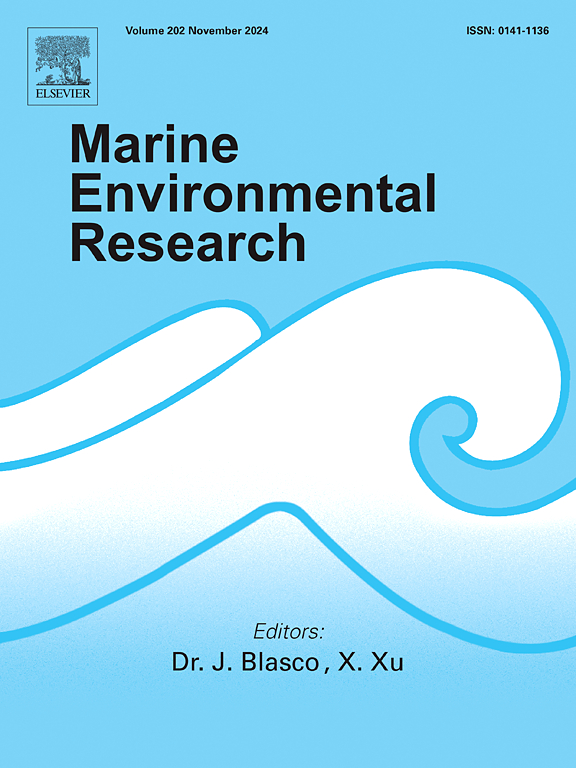Application of satellite and bio-argo float-based estimation of particulate organic carbon for ecosystem monitoring in the Arabian sea
IF 3.2
3区 环境科学与生态学
Q2 ENVIRONMENTAL SCIENCES
引用次数: 0
Abstract
Particulate organic carbon (POC) is an essential environmental parameter playing a crucial role in the biogeochemical carbon cycle. The present study estimates POC concentration, in the Arabian Sea, using satellite and bio-Argo float, providing time and three-dimensional space coverage. The satellite-derived POC concentration, using remote sensing reflectance, showed a good correlation (R2 = 0.79) with the in-situ derived using backscattering coefficient, giving the confidence to combine these data for further analysis. Strong seasonality was observed in the surface and sub-surface distribution of POC concentration. During the southwest monsoon season, high POC concentration was observed along the coast primarily due to increased productivity by upwelling-induced nutrients. In contrast, during the northeast monsoon, higher POC concentration was observed in the northern Arabian Sea due to a boost in productivity due to nutrient influx through convective mixing. Although the POC concentration distribution was similar to chlorophyll-a (chl-a), their rate varied, as evident from the POC to chl-a ratio. The vertical distribution of POC concentration showed a remarkable Intermediate Nepheloid Layer (INL) between ∼200 and ∼400m, where suspended particle concentrations are higher than those in adjacent ocean layers. The INL was associated with high POC, low oxygen, and lower nitrate. The increase in subsurface POC may likely be due to the export flux and the associated low nitrate and high nitrite, below the thermocline and within the INL, under low oxygen, indicated the denitrification process. The significant findings from the study have enhanced the understanding of POC dynamics for effective monitoring of the ecosystem.

基于卫星和生物浮标的颗粒有机碳估算在阿拉伯海生态系统监测中的应用
颗粒有机碳(POC)是一个重要的环境参数,在生物地球化学碳循环中起着重要作用。本研究利用卫星和生物argo浮标估算了阿拉伯海的POC浓度,提供了时间和三维空间覆盖。利用遥感反射率反演的卫星POC浓度与利用后向散射系数反演的原位POC浓度具有良好的相关关系(R2 = 0.79),为结合这些数据进行进一步分析提供了信心。地表和地下POC浓度分布具有较强的季节性。在西南季风季节,沿海岸观测到高POC浓度主要是由于上升流诱导的营养物质增加了生产力。相反,在东北季风期间,在阿拉伯海北部观测到较高的POC浓度,这是由于对流混合带来的营养物质流入提高了生产力。虽然POC浓度分布与叶绿素-a (chl-a)相似,但它们的速率不同,从POC与chl-a的比值可见一斑。POC浓度垂直分布在~ 200 ~ ~ 400m之间表现为显著的中间Nepheloid Layer (INL),该层悬浮粒子浓度高于邻近海洋层。INL与高POC、低氧和低硝酸盐有关。地下POC的增加可能是由于出口通量和相关的低硝酸盐和高亚硝酸盐,在温跃层以下和INL内,在低氧下,表明了反硝化过程。该研究的重要发现增强了对POC动态的理解,有助于有效监测生态系统。
本文章由计算机程序翻译,如有差异,请以英文原文为准。
求助全文
约1分钟内获得全文
求助全文
来源期刊

Marine environmental research
环境科学-毒理学
CiteScore
5.90
自引率
3.00%
发文量
217
审稿时长
46 days
期刊介绍:
Marine Environmental Research publishes original research papers on chemical, physical, and biological interactions in the oceans and coastal waters. The journal serves as a forum for new information on biology, chemistry, and toxicology and syntheses that advance understanding of marine environmental processes.
Submission of multidisciplinary studies is encouraged. Studies that utilize experimental approaches to clarify the roles of anthropogenic and natural causes of changes in marine ecosystems are especially welcome, as are those studies that represent new developments of a theoretical or conceptual aspect of marine science. All papers published in this journal are reviewed by qualified peers prior to acceptance and publication. Examples of topics considered to be appropriate for the journal include, but are not limited to, the following:
– The extent, persistence, and consequences of change and the recovery from such change in natural marine systems
– The biochemical, physiological, and ecological consequences of contaminants to marine organisms and ecosystems
– The biogeochemistry of naturally occurring and anthropogenic substances
– Models that describe and predict the above processes
– Monitoring studies, to the extent that their results provide new information on functional processes
– Methodological papers describing improved quantitative techniques for the marine sciences.
 求助内容:
求助内容: 应助结果提醒方式:
应助结果提醒方式:


